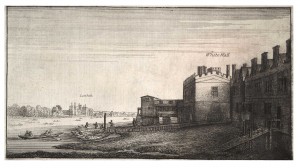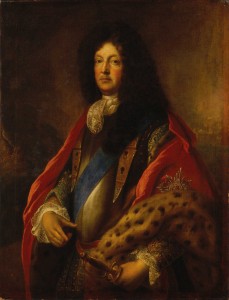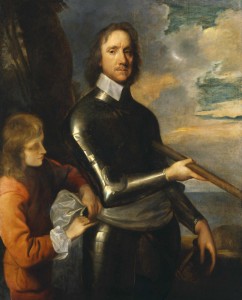Richard Talbot—the man who didn’t kill Cromwell
Published in Early Modern History (1500–1700), Features, Issue 3 (May/June 2015), Volume 23The Stuart court-in-exile sponsored many schemes to assassinate Oliver Cromwell throughout the 1650s. Most plans envisioned a handful of gunmen ambushing the lord protector and his mounted escorts as they picked their way through narrow streets from Whitehall Palace to Hampton Court, where the protector was wont to spend his weekends, or elsewhere. Éamonn Ó Ciardha’s ‘“Fighting Dick” Talbot, “the Chevalier” Wogan and Lally-Tollendal: jailbreakers and jailbirds’ (HI 19.2, March/April 2011) touched on one of these abortive assassination plots.
Plotting against the protector
In 1655 Colonel John Stephens, an Ormond client, and Daniel O’Neill set in train the latest assassination plot. Dick Talbot volunteered for the hazardous mission. On 13 July Henry Manning, Secretary Thurloe’s spy at Cologne, warned that Talbot, ‘a tall young man’, and Robert Dongan, Ormond’s page and Talbot’s nephew, would pass through Dover on their way to help Stephens and Colonel James Halsall assassinate the protector. Stephens and Talbot were duly arrested sometime before the end of July but were soon set free. Once released, they badgered Halsall to press on, but Halsall temporised and a thoroughly disillusioned Stephens crossed back over the Channel. On 16 November Halsall was seized in his lodgings and his cipher and papers were pulled from the lining of his hat. Talbot and Dongan were also rounded up. Nine days later Thurloe interrogated Halsall, who stoutly denied that there was any assassination plot.
In December 1655 Manning was unmasked as an informer and some royalists not unreasonably assumed that he was to blame for the arrests. Not so Hyde; he interrogated the wretched spy, who confessed that he had warned Whitehall about Talbot’s departure from Cologne but did not admit to knowing anything else, let alone Halsall’s hiding place in London. Shortly afterwards a party of cavaliers took Manning to a secluded copse outside Cologne and shot him dead.
Meanwhile Thurloe questioned Talbot at Whitehall, with Cromwell present for some of the interrogation. The protector began by offering ‘great preferments’: likely he or Thurloe promised to excuse Talbot’s mother, eldest brother and sisters from transplantation to Connacht. Cromwell next claimed kinship through the Talbot earls of Shrewsbury, and then abruptly demanded to know why Talbot would kill a man who had ‘never prejudiced him in his life’. Peter Talbot, recounting what his brother told him of the interrogation, snorted that ‘nothing made me laugh more’. Cromwell insinuated that Halsall had cracked under interrogation and had sold Talbot out, but the young cavalier kept his nerve and flatly denied a connection with any plot. As luck would have it, his name was not in Halsall’s captured cipher. Frustrated, Cromwell gave up but paused at the door to threaten that he would get at the truth even if he had to ‘spin it out of his bones’. Talbot defiantly retorted that even if he were to ‘spin him to a thread’ he could only invent lies. Thurloe made ‘great offers of money’ to the prisoner before reminding him that he would be sent to the Tower of London the very next day. Realising that escape would then be more difficult, Talbot spent his remaining money and ‘bestowed much wine’ on Cromwell’s servants that night (sometime in mid-December 1655) before slipping down a rope cast from a window to the Thames, where a river boat awaited. Ten days later he disembarked at Calais and made his way with his brothers Peter and Gilbert to Antwerp, which they reached on 3 January 1656.
Was Talbot a traitor?

Most assassination plans envisioned a handful of gunmen ambushing the lord protector and his mounted escorts as they picked their way through the narrow streets of Whitehall (to the right of this contemporary Wencelas Hollar engraving).
Richard wrote a report to Ormond on his capture, interrogation and escape, but it looked retrospectively suspicious when, shortly afterwards, he happened to be accompanying his brother Gilbert as the latter was caught red-handed collecting correspondence from Thurloe at the Antwerp post-house. Pointing out that Thurloe was grumbling in the letter about the lack of hard intelligence, Gilbert or ‘Monsieur Burford’ pleaded that he was simply pretending to spy for the protector as a way to cadge money from Thurloe. Hyde promptly wrote off Richard, Peter and Gilbert Talbot as a pack of knaves. At this juncture Robert Dongan, who had been sprung from prison in London by the Royalist underground, cited rumours to Ormond that seemed to bolster Hyde’s suspicions:
‘I make noe questions that have herd of them reports that were of Dicke Talbot, but I could not get any ground for them. But every body must answer for himself …’
Languishing in the Tower, Halsall brooded over who had betrayed him and concluded that his servant, William Marston, was the only one who knew ‘all his business’, including where he had hidden his papers. Halsall passed on a scribbled warning to Ormond, but that this was not enough to exonerate Dick Talbot is clear from the tenor of a letter that Peter wrote to Ormond at the beginning of February 1656. Sergeant, Richard Talbot’s biographer, was disgusted at Peter’s less than ‘brotherly’ attitude and, on the face of it, his letter damns his younger brother with faint defence: ‘I will neither flatter my inclination with judging him innocent nor bee rash in my condemning him’. A more careful parsing of that letter suggests, however, that neutrality was but a disingenuous pose to let him argue all the more effectively on Richard’s behalf. He claimed that it was really ‘Gilbert’s business’ that cast suspicion on Richard, implicitly discounting Robert Dongan’s rumour-mongering, and concluded with a telling argument: ‘Truly I thinke [Gilbert] would have more credit with his correspondent than hee hath if Dick were a knave’.
Like everyone else involved, Richard appealed to Ormond. On 1 February 1656, Richard hinted at Halsall’s ‘cowardice or some private end’: he was evidently still not sure whether Halsall had been the one (he actually hadn’t) to first point the finger at him. Talbot was hard put to prove a negative, that he was not a spy, and instead reminded Ormond of long-standing Talbot family loyalty to Ormond. Richard’s appeal did not explicitly recite his sufferings but he himself had been gravely wounded, stripped and left for dead at the sack of Drogheda. If the other two occasions when he was taken prisoner (in 1647 and 1650) are anything to go by, he fell because he was the last to flee, fighting to the end:
‘I always thought that the testimonyes all those of my family gave of thyr fidelity to the Kings servis and in particular to Yr Excey and the many hazard that myself hath lately run in order thereunto ought merit a better opinion of mee than I find thear is held of mee by some of the King’s ministers thear, to be Cromwell’s only intelligence hear; if the loss of so much blood as I have lost in the servis, the quieting of my fortune hear the last summer to go into England to venter the lives of my friends and my owne, my imprisonment for six months … and lastly my life lost (if I had not made my escape) bee not motives sufficient to justify mee.’
He pointed to the ‘bare surmises’ rather than hard evidence against him and implored Ormond: ‘… since you have always been a patron of us all, I humbly crave your assistance’. Ormond obliged by demonstrating his confidence in Gilbert and Richard by having them accompany him to meet Princess Mary Stuart, Charles’s older sister and mother of our ‘King Billy’.
Were Hyde’s suspicions justified? Talbot’s twice escaping from custody smacks of connivance by the authorities. On the first occasion, a spy warned Thurloe to ‘Take a care of releasing the Irish Talbot’, but the tip-off came after Talbot, along with Dongan and Stephens, had been released, probably as unwitting bait to net bigger fish. The second escape seems implausibly theatrical until one learns that time and again royalists escaped from imprisonment by scrambling out windows, tying sheets together to make ropes or dressing up in women’s clothes. The fact is that the protectorate’s security was poor (Talbot’s accuser Dongan had himself broken out of gaol) and turnkeys often took bribes to look the other way. The following year Dick Hopton, another would-be assassin, also broke out of Whitehall in time to be wounded in a duel by Talbot over a bet laid on a game of tennis.
Quite apart from unmasked traitors like Manning and Marston, there had been loose talk among royalists that ‘Cromwell shall not live long’. Dongan, in particular, had been blamed for being indiscreet and his insinuations may have been no more than a bid to deflect blame.
Consequences
‘Uneasy lies the head that wears a crown’: one imagines that assassination plots like Talbot’s must have given the protector some sleepless nights, but the main significance of the event lies in the fact that Richard Talbot’s bid to gain credit with the Old Royalists backfired. True, Ormond took his client back under his protection, but any rapprochement between the Talbots and the Old Royalists was fleeting. It was possible for an Irish Catholic like Richard Bellings to thrive in Ormond’s shadow but only if he were an utterly uncritical follower with few thoughts for the Irish Catholic community at large. In contrast, Peter’s politico-religious ambitions were uncontainable, and after the foiled assassination he renewed his pleas that Charles II should secretly become a Catholic, whereupon the pope and the king of Spain would supposedly ‘engage themselves to get him all his own again’. Hyde and Ormond were aghast at the Jesuit’s incorrigible proselytising, and Richard’s guilt by association (quite apart from the whiff of treachery lingering about him) meant that he had no future in Old Royalist circles.
Opportunity, however, beckoned at yet another, third, Stuart court. A definitive Anglo-French alliance pushed Philip IV of Spain and Charles II into a counter-alliance in which Charles was promised a subsidy and allowed to move his court to the Spanish Netherlands. Charles’s alignment with Spain widened the gap between mother and son and between their respective Louvrian and Old Royalist factions. Charles purged suspected ‘Louvrians’ from the household of his younger brother, James, duke of York (who would reign as James II 30 years later), but in response York fled the court. Fearing that this would undo his deal with the Spanish, Charles backed down and allowed his brother a position of power and some autonomy as master of what was almost a rival court, where York promptly dismissed all courtiers but ‘such as were absolutely his own’.
Peter found York more appreciative of his influence in Brussels and Madrid than Charles, and he was well placed to insinuate brother Dick into this expanding court. Even Hyde could see why York appointed Talbot as a groom of the bedchamber: ‘He was a very handsome young man [who] wore good cloaths and was without Doubt of clear ready Courage which was Virtue enough to recommend a Man to the Duke’. The clearest proof of his courage had been the bid to kill Cromwell. With this gaisce, Talbot forged that enduring connection which would shape his entire career.
Old Royalist disdain, so painfully apparent after the failed plot, began to push the Talbots towards what would emerge after the Restoration of 1660 as an opposing faction of out-groups (such as Catholics and Presbyterians) and hungry opportunists. Talbot’s final disenchantment with Ormond would not come until 1664, after the now lord lieutenant of Ireland put through an Act of Settlement that more or less confirmed the Cromwellian land confiscations. Talbot accosted the great man at his apartments in Chelsea and abused him for selling out his Irish Catholic followers. Ormond hastened to the king to complain that he had been insulted and implicitly challenged to fight a duel merely for carrying out his official duties. Charles was duly ‘incensed’ and punished Talbot for his ‘insolent presumption’. Nine years after the assassination plot, Talbot finally got to see the inside of the Tower.
Pádraig Lenihan lectures in history at NUI Galway.
Read More: The Talbot brothers
Further reading
J.J. Cronin, ‘Monarchy and exile: the political activities of an exiled royal court and the role played by its Irish courtiers’, in P. Mansel & T. Riotte (eds), Monarchy and exile: the politics of legitimacy from Marie de Médicis to Wilhelm II (London, 2011), 144–65.
P. Lenihan, The last cavalier: Richard Talbot (1631–91) (Dublin, 2014).
G. Smith, The cavaliers in exile, 1650–1660 (London, 2003).
M. Williams, The king’s Irishmen: the Irish in the exiled court of Charles II, 1649–1660 (Martlesham, 2015).


















